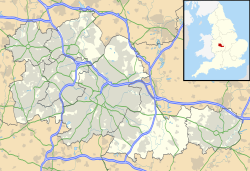| Rubery Hill Hospital | |
|---|---|
 The former hospital chapel | |
| Geography | |
| Location | Nightingale Grove, Birmingham, West Midlands, England |
| Coordinates | 52°23′54″N2°00′51″W / 52.3982°N 2.0143°W |
| Organisation | |
| Care system | NHS |
| Type | Specialist |
| Services | |
| Emergency department | N/A |
| Speciality | Psychiatric Hospital |
| History | |
| Opened | 1882 |
| Closed | 1993 |
| Links | |
| Lists | Hospitals in England |
Rubery Hill Hospital was a mental health facility in Birmingham, England. The chapel, which still survives, is a Grade II listed building. [1]
